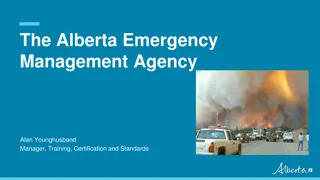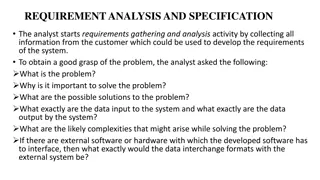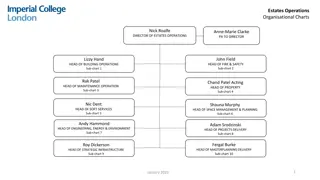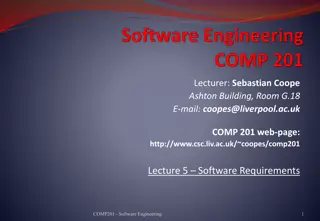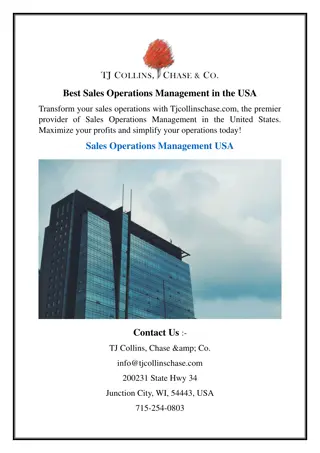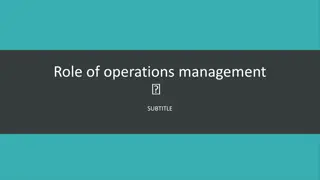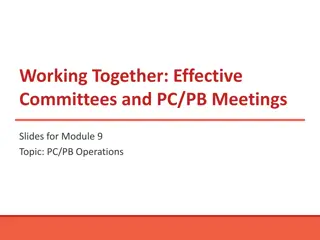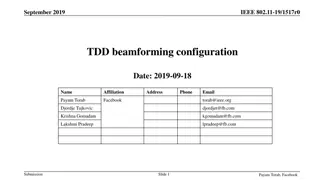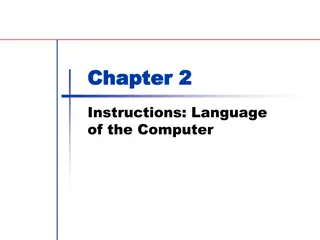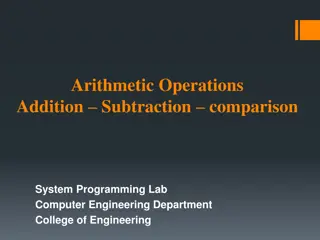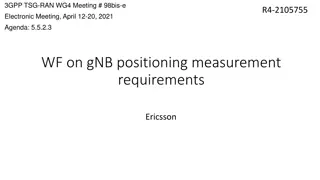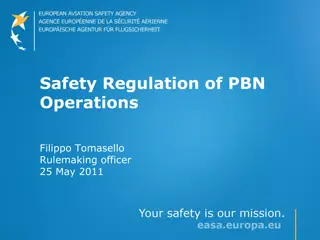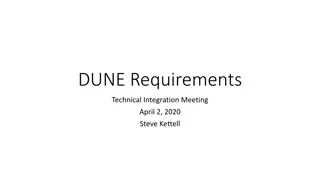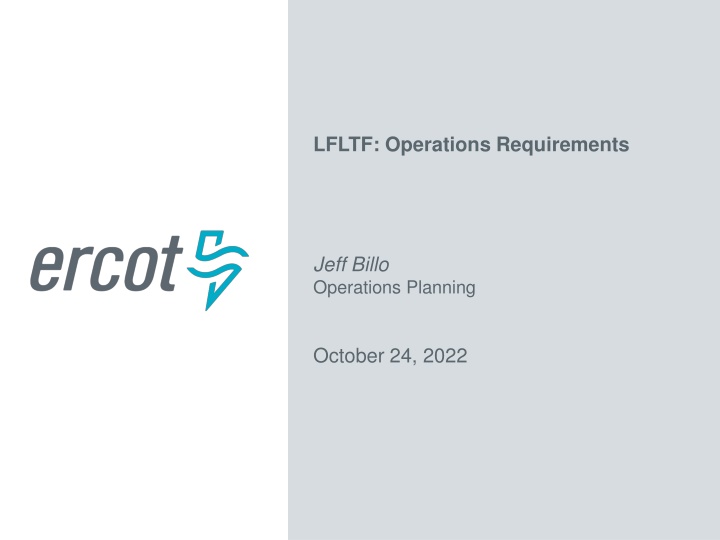
ERCOT Operations Overview: Power Generation and Ancillary Services
Learn about the fundamental concepts of ERCOT operations where power generation must match load demand, and ancillary services play a crucial role in maintaining grid stability by balancing supply and demand through various services.
Uploaded on | 2 Views
Download Presentation

Please find below an Image/Link to download the presentation.
The content on the website is provided AS IS for your information and personal use only. It may not be sold, licensed, or shared on other websites without obtaining consent from the author. If you encounter any issues during the download, it is possible that the publisher has removed the file from their server.
You are allowed to download the files provided on this website for personal or commercial use, subject to the condition that they are used lawfully. All files are the property of their respective owners.
The content on the website is provided AS IS for your information and personal use only. It may not be sold, licensed, or shared on other websites without obtaining consent from the author.
E N D
Presentation Transcript
LFLTF: Operations Requirements Jeff Billo Operations Planning October 24, 2022
Power Supply (Generation) Must Match Load (Demand) A fundamental concept behind ERCOT operations is that generation has to match load at all times A 1 MW reduction in load has the same effect on the grid as a 1 MW increase in generation. 2 PUBLIC
Ancillary Services Load and generation are constantly changing, due to: Daily load patterns Instantaneous changes in variable generation output Generators tripping offline Ancillary Service Products Regulation Service (Reg) Reserved capacity that is deployed every 4 seconds to balance supply and demand and maintain frequency close to 60Hz between 5-minute SCED runs. Ancillary Services are procured in the Day-Ahead Market to ensure extra capacity is available to address variability that cannot be covered by the five-minute energy market. Minimum quantities of each type of ancillary service are reviewed annually and can be increased during the year as required Responsive Reserve Service (RRS) Reserved capacity that is procured to respond to low frequency events typically triggered by generating unit trips. ERCOT Contingency Reserve Service (ECRS) in development Capacity that can be started in 10 minutes to cover forecast errors or ramps and replace deployed reserves. Non-Spin Reserve Service Capacity that can be started in 30 minutes to cover forecast errors, forced outages or ramps and replace deployed reserves until additional resources can be committed. 3 PUBLIC
Security Constrained Economic Dispatch (SCED) SCED produces a Base Point (BP) for resources each 5-minute. However, both load and generation can change minute-by-minute within a SCED time interval, thus requiring Reg resources to be deployed to maintain a balance between demand and supply Deployment of Reg Resources 4 PUBLIC
Maximum 5-min Change of Load/Wind/Solar (Jan. 1, 2022-Sep. 30, 2022) The maximum change of net load* within 5 minutes from Jan. 1, 2022 through Sep. 30, 2022 was 1,055 MW (Up) and 1,232 MW (Down) Max 5-min Change Up Down Load Wind Solar Net load 791 MW -1,242 MW 808 MW -680 MW 752 MW -1,020 MW 1,055 MW -1,232 MW * Net load = Load less wind and solar generation 5 PUBLIC
Regulation Quantities Month-hour Regulation quantities are calculated on an annual basis In 2022: Reg Up ranged from 73 MW to 684 MW Reg Down ranged from 151 MW to 631 MW Each year the quantities are adjusted to account for observed net load variability and expected wind and solar generation additions 6 PUBLIC
Frequency Bias Frequency Bias is the Balancing Authority s obligation to provide or absorb energy to assist in stabilizing frequency A common approach is to set frequency bias per the 1% of load method. 1 Meaning, if load is around 70,000 MW and there were to be a 700 MW imbalance between load and generation and no action was taken*, the frequency would be expected to settle out at 0.1 Hz above or below 60 Hz depending on the direction of the imbalance Extrapolating this out: Frequency Deviation @ 70 GW Load 700 MW ~0.1 Hz 3,500 MW ~0.5 Hz 5,000 MW ~0.7 Hz Frequency Deviation @ 35 GW Load ~0.2 Hz ~1.0 Hz ~1.4 Hz Imbalance 1 NERC Balancing and Frequency Control Technical Document * In practice, operator action, Ancillary Services, and/or UFLS would work to bring the system back into balance to prevent the system from settling at such a frequency deviation 7 PUBLIC
Frequency Control 60.05 60 Frequency Recovered to 60Hz. 59.95 59.9 RRS Capacity Released to SCED at 59.91Hz 59.85 FFR Deployed at 59.85Hz 59.8 RRS Triggered SCED Run Hydro Deployed at 59.8Hz 59.75 Load Resources Deployed at 59.7Hz 59.7 59.65 59.6 Governor Deadband Frequency RRS FFR Hydro 8 PUBLIC
Frequency Events Historic Trends * Excludes February 2021 9 PUBLIC
NERC Frequency Control Related Rules NERC has a series of Standards that enforce frequency control requirements on Balancing Authorities like ERCOT. Some relevant standards are listed below: BAL-001-2 Real Power Balancing Control Performance To control Interconnection frequency within defined limits. BAL-001-TRE-2 - Primary Frequency Response in the ERCOT Region To maintain Interconnection steady-state frequency within defined limits. BAL-002-3 Disturbance Control Standard Contingency Reserve for Recovery from a Balancing Contingency Event To ensure the Balancing Authority balances resources and demand and returns the Balancing Authority's Area Control Error to defined values (subject to applicable limits) following a Reportable Balancing Contingency Event. BAL-003-2 Frequency Response and Frequency Bias Setting To require sufficient Frequency Response from the Balancing Authority (BA) to maintain Interconnection Frequency within predefined bounds by arresting frequency deviations and supporting frequency until the frequency is restored to its scheduled value. To provide consistent methods for measuring Frequency Response and determining the Frequency Bias Setting. 10 PUBLIC
Putting It All Together ERCOT maintains frequency close to 60 Hz at all times ERCOT must follow NERC Reliability Standards regarding frequency control SCED dispatches generation every 5 minutes to meet forecasted changes in net load Regulation Up/Down is deployed to maintain frequency between SCED intervals Regulation quantities are calculated on an annual basis and account for observed net load variation and expected changes in wind and solar generation capacity Historically, net load changes between 5-minute intervals have typically been below 1,000 MW 11 PUBLIC
Observations from LFLs Summer 2022 Behavior LFLs (known) not carrying Ancillary Services generally increased/decreased consumption in a similar pattern The below example illustrates LFL consumption on July 18 Largest 1-min decrease: 11% @ 13:02 Largest 1-min increase: 6% @ 21:11 Largest 5-min decrease: 27% @ 13:05 Largest 5-min increase: 21% @ 21:12 Largest 10-min decrease: 37% @ 13:05 Largest 10-min increase: 30% @ 21:13 *Percentages relative to the maximum aggregate consumption on July 18 12 PUBLIC
LFL Behavior (Jan. 1, 2022-Sep. 30, 2022) ERCOT has seen large 1-min and 5-min ramp of individual LFLs this year. If not constrained, the magnitude of 1-min and 5-min ramps could increase in proportion to the total capacity of LFLs, which presents a challenge to the frequency control at ERCOT 95th percentile 99.8th percentile 100th percentile 1-min change (Up) 1-min change (Down) 5-min change (Up) 5-min change (Down) 10 MW -11 MW 43 MW -66 MW 301 MW -256 MW 27 MW -31 MW 98 MW -135 MW 719 MW -804 MW 13 PUBLIC
Thoughts on Observations from Summer 2022 Behavior LFLs that are in SCED and have a moderate ramp rate limitation will not cause reliability concerns i.e. SCED will dispatch resources to meet forecasted net load Ramp rate requirement should allow 100% change in consumption proportionally over 5-minute interval If there are thousands of MWs of LFLs that are not in SCED and they exhibit behavior like in the previous graphic, it will lead to sizable generation-load imbalances at times Diversity in response may help somewhat but will likely not solve the issue It is likely not practical to just increase Regulation quantities to meet the system needs for these conditions An LFL ramp rate restriction will be needed to mitigate this concern 14 PUBLIC
Voltage Ride-Through (VRT) When there is a fault on the system, voltage at the location of the fault will go to zero volts and voltage in the vicinity of the fault will be depressed Equipment that is not designed to stay online ( ride-through ) during the depressed voltage can cause or exacerbate reliability problems Frequency instability Voltage instability (low or high) Other issues 15 PUBLIC
On 10/12/22 at 5:56 am, four faults occurred in the West region VRT Event On October 12, there was a load voltage ride- through event in West Texas Several loads totaling >400 MWs tripped, including LFL Lowest recorded voltage was 0.36pu. ERCOT is still investigating this event Four frequency swings. Highest frequency 60.09 Hz. 16 PUBLIC
For Reference: Nodal Operating Guide 2.9.1 Current Requirement for Intermittent Renewable Resources 1.2 1.1 1.0 Voltage (per unit) @ POIB 0.9 0.8 0.7 No Tripping 0.6 0.5 0.4 0.3 0.2 0.1 0 0.15 1 -1 0 2 (9 cycles) Time (Seconds) Pre-fault Period Voltage Recovery Period Fault Clearing Period 17 PUBLIC
Next Steps ERCOT will work with TDSPs on framework for ramp rate and voltage ride-through requirements ERCOT will develop draft ramp rate and voltage ride- through requirements 18 PUBLIC

